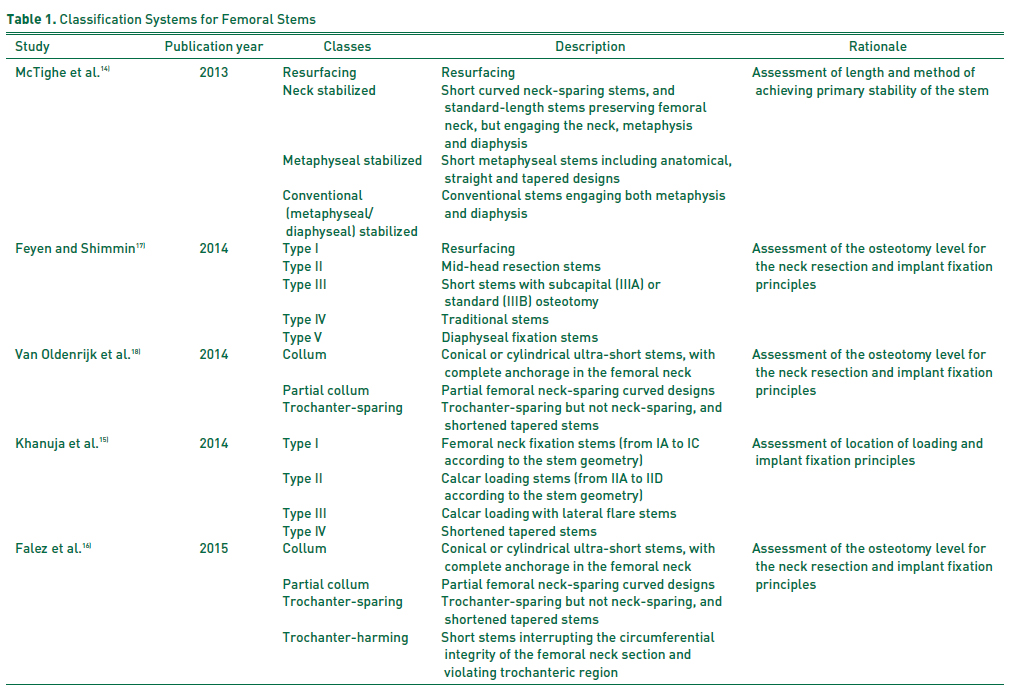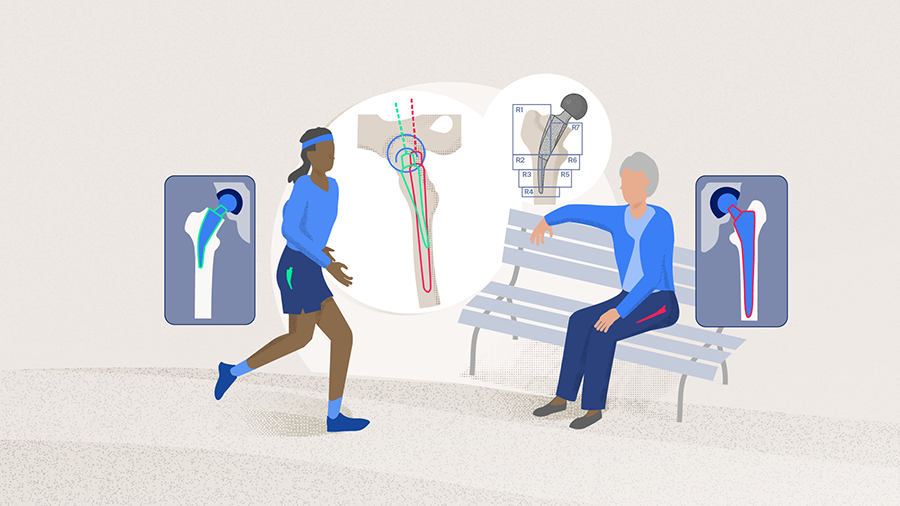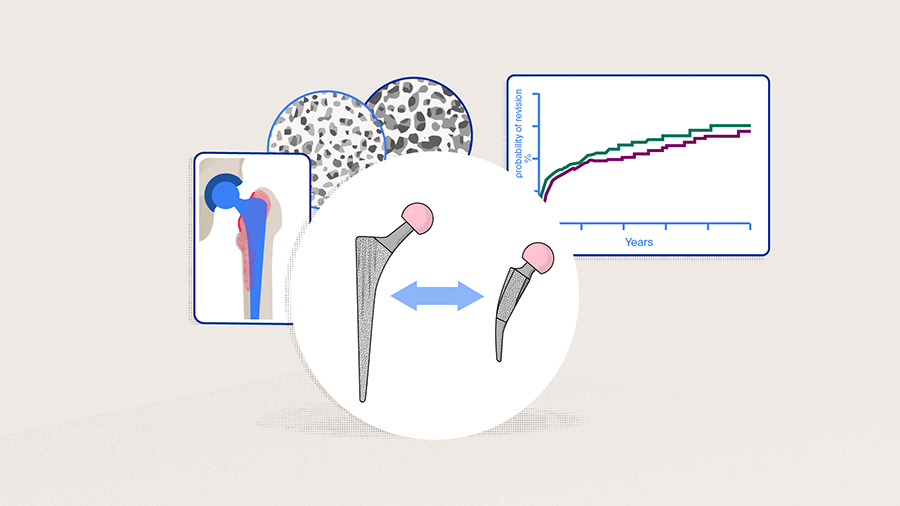Midterm results of short-stem total hip arthroplasty
Preview
In Part 1 of this series of articles we have discussed the main biomechanical advantages of a short stem over a standard stem in total hip arthroplasty (THA). Based on the biomechanical evidence, short stems should provide reasonable primary stability and potentially reduce stress shielding. How have the short stems performed clinically so far? In this article, Martin Buttaro, chief orthopedic surgeon at the Hospital Italiano de Buenos Aires, Argentina, reviews for us the midterm (ie, 4–10 years) clinical results—more specifically, the midterm implant survival, bone remodeling, and functional and patient outcomes.

Martin Buttaro
Italian Hospital Buenos Aires, Argentina
A classification of short stems is still elusive
Although short stems have been described as stems that are shorter than 120 mm [1], some have argued that they should not be defined by a simple length limit and that the design features should be taken into consideration as well [2–4]. Over the past two decades, a large number of short stems have been launched (and many have since been taken off the market), and a clear classification system would be useful for comparing their performance and helpful in their selection of an appropriate implant.
As has been reviewed by Y-H Kim [5], many have tried to classify short stems based on different considerations (see Table 1 for a nonexhaustive summary).
Due to the many potential design features (such as the length, shape, neck resection location, loading principle, and fixation principle) to be considered in a classification system, the definition of a short stem is still not settled, and so far, none of the systems have achieved universal usage. Currently, the Khanuja [6] and the Falez [2] systems are the more commonly cited ones.
Implant survival: data from a German registry
Short-stem THA has been gaining popularity; the German Arthroplasty Registry (EPRD) reported that more than 10% of all primary THAs have been performed using short stems [4].
In assessing the performance of short stems according to the EPRD records, Steinbrück et al extracted data from 266,702 primary THAs conducted between November 1, 2012 and September 30, 2019. After selecting data sets with complete follow-up from clinics with information about their case load, 17,526 primary short-stem THAs were selected for further analyses. In the analyses, the authors stratified the data for four most frequently used short stems. As shown in Table 2, among these four stems, the 5-year cumulative probability of revision (CPR) for the Optimys stems was 1.8%—better than the Metha (3.7%) and the Nanos (3.1%) stems. The authors nevertheless cautioned the readers that, in the clinics where the short stems were used and the data were extracted from, the Optimys stems were more frequently used (40% of all THAs) than the Metha and the Nanos stems (15% and 26% of all THAs, respectively), therefore an "expertise bias" is possible [4].
Read the full article with your AO login
- Overall midterm implant survival of 97% or greater
- Subsidence and migration
- Stress shielding: a comparison of different short stems
- Midterm results on stress shielding and bone remodeling
- Clinical outcomes: function and pain
- What do the midterm results tell us about short-stem total hip arthroplasty?
Additional AO resources
Access videos, tools, and other assets.
- Videos
- Books in Thieme store
- AO Surgery Reference
- Upcoming events: AO Recon Course finder
Contributing experts
This series of articles was created with the support of the following specialists (in alphabetical order):

Martin Buttaro
Italian Hospital Buenos Aires, Argentina

Marco Ezechieli
Vincenz Group Paderborn, St Josefs Hospital Salzkotten, Germany

Carlos Martin Lucero
Italian Hospital Buenos Aires, Argentina
This issue was written by Maio Chen, AO Innovation Translation Center, Clinical Science, Switzerland.
References
- Stulberg SD, Patel RM. The short stem: promises and pitfalls. Bone Joint J. 2013 Nov;95-b(11 Suppl A):57-62.
- Falez F, Casella F, Papalia M. Current concepts, classification, and results in short stem hip arthroplasty. Orthopedics. 2015 Mar;38(3 Suppl):S6-13.
- Buttaro MA, Slullitel PA, Oñativia JI, et al. 4- to 8-year complication analysis of 2 'partial collum' femoral stems in primary THA. Hip Int. 2021 Jan;31(1):75-82.
- Steinbrück A, Grimberg AW, Elliott J, et al. Short versus conventional stem in cementless total hip arthroplasty : An evidence-based approach with registry data of mid-term survival. Orthopade. 2021 Apr;50(4):296-305.
- Kim Y-H. Ultra-Short Bone Conserving Cementless Femoral Stem. Hip Pelvis. 2021 12/;33(4):181-189.
- Khanuja HS, Banerjee S, Jain D, et al. Short bone-conserving stems in cementless hip arthroplasty. J Bone Joint Surg Am. 2014 Oct 15;96(20):1742-1752.
- von Engelhardt LV, Breil-Wirth A, Kothny C, et al. Long-term results of an anatomically implanted hip arthroplasty with a short stem prosthesis (MiniHip(TM)). World J Orthop. 2018 Oct 18;9(10):210-219.
- Kutzner KP, Donner S, Loweg L, et al. Mid-term results of a new-generation calcar-guided short stem in THA: clinical and radiological 5-year follow-up of 216 cases. J Orthop Traumatol. 2019 Oct 31;20(1):31.
- Zimmerer A, Slouka S, Kinkel S, et al. Comparison of short-stem with conventional-stem prostheses in total hip arthroplasty: an 8-year follow-up study. Arch Orthop Trauma Surg. 2020 Sep;140(9):1285-1291.
- Blakeney WG, Lavigne M, Beaulieu Y, et al. Mid-term results of total hip arthroplasty using a novel uncemented short femoral stem with metaphyso-diaphyseal fixation. Hip Int. 2021 Jan;31(1):83-89.
- Drobniewski M, Synder M, Synder MA, et al. Future of total hip arthroplasty with the Metha short stem in modern surgeries. Scientific Reports. 2021 2021/11/05;11(1):21763.
- Suksathien Y, Suarjui J, Ruangboon C, et al. Mid-term results of short versus conventional cementless femoral stems in patients with bilateral osteonecrosis of the femoral head. Eur J Orthop Surg Traumatol. 2021 Mar 12.
- Suksathien Y, Tippimanchai T, Akkrasaeng T, et al. Mid-term results of short-stem total hip arthroplasty in patients with Crowe type I and II developmental dysplasia of the hip. Eur J Orthop Surg Traumatol. 2021 Feb;31(2):319-325.
- Amendola RL, Goetz DD, Liu SS, et al. Two- to 4-Year Followup of a Short Stem THA Construct: Excellent Fixation, Thigh Pain a Concern. Clin Orthop Relat Res. 2017 Feb;475(2):375-383.
- Kärrholm J, Borssén B, Löwenhielm G, et al. Does early micromotion of femoral stem prostheses matter? 4-7-year stereoradiographic follow-up of 84 cemented prostheses. J Bone Joint Surg Br. 1994 Nov;76(6):912-917.
- Krismer M, Biedermann R, Stöckl B, et al. The prediction of failure of the stem in THR by measurement of early migration using EBRA-FCA. Einzel-Bild-Roentgen-Analyse-femoral component analysis. J Bone Joint Surg Br. 1999 Mar;81(2):273-280.
- Floerkemeier T, Budde S, Lewinski GV, et al. Greater early migration of a short-stem total hip arthroplasty is not associated with an increased risk of osseointegration failure: 5th-year results from a prospective RSA study with 39 patients, a follow-up study. Acta Orthop. 2020 Jun;91(3):266-271.
- Budde S, Seehaus F, Schwarze M, et al. Analysis of migration of the Nanos® short-stem hip implant within two years after surgery. Int Orthop. 2016 Aug;40(8):1607-1614.
- Freitag T, Fuchs M, Woelfle-Roos JV, et al. Mid-term migration analysis of a femoral short-stem prosthesis: a five-year EBRA-FCA-study. HIP International. 2019;29(2):128-133.
- Kutzner KP, Ried E, Donner S, et al. Mid-term migration pattern of a calcar-guided short stem: A five-year EBRA-FCA-study. Journal of Orthopaedic Science. 2020 2020/11/01/;25(6):1015-1020.
- Yan SG, Weber P, Steinbrück A, et al. Periprosthetic bone remodelling of short-stem total hip arthroplasty: a systematic review. Int Orthop. 2018 Sep;42(9):2077-2086.
- Meyer JS, Freitag T, Reichel H, et al. Mid-term gender-specific differences in periprosthetic bone remodelling after implantation of a curved bone-preserving hip stem. Orthop Traumatol Surg Res. 2020 Dec;106(8):1495-1500.
- Huo SC, Wang F, Dong LJ, et al. Short-stem prostheses in primary total hip arthroplasty: A meta-analysis of randomized controlled trials. Medicine (Baltimore). 2016 Oct;95(43):e5215.
- Jahnke A, Wiesmair AK, Fonseca Ulloa CA, et al. Outcome of short- to medium-term migration analysis of a cementless short stem total hip arthroplasty using EBRA-FCA: a radiological and clinical study. Arch Orthop Trauma Surg. 2020 Feb;140(2):247-253.






